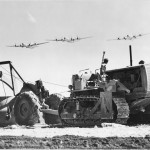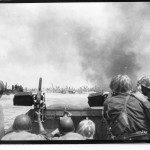Explore the War in the Pacific with These Summer Reading Titles
- Use the hashtag #getinthescrap on Twitter or Instagram to explore what participants in the Museum's national service learning program have been up to this year.
- In the Marianas, US Army and Navy builders constructed airfield facilities that allowed B-29 Superfortress bombers to fly from Saipan, Tinian, and Guam to rain fire and explosives on the Japanese home islands. (National Archives and Records Administration, 342-FH-3A-39165.)
- Using armored amphibious tractors, a joint US Navy-Marines-Army force captures Kwajalein and Roi-Namur in the Marshall Islands in early 1944. These islands hold strategic airfields and naval bases and are a key stepping-stone to the Mariana Islands. (National Archives and Records Administration, 111 SC 187435.)
Summer is approaching, so this month’s Calling All Teachers e-newsletter features recommended reading for you and your students.
Two of the featured titles – Graham Salisbury’s Under the Blood-Red Sun and Jonathan Fetter-Vorm’s Trinity – explore World War II in the Pacific. Another – Tanita Davis’s Mare’s War – chronicles one fictional veteran’s experiences in the Women’s Army Corps (WAC).
Since the Museum has hosted webinars with these authors, you and your students can view the archived programs here.
The June Calling All Teachers e-newsletter also provides a recap of the Get in the Scrap! Service Learning Project, which ended its inaugural year May 31. The newsletter also highlights the entertaining and educational end-of-the-year and summertime activities that you can find in the Museum’s Kids Corner.
Finally, this month’s Calling All Teachers shines the spotlight on D-Days in Europe and the Pacific. D-Day was the military term used to indicate the date for a planned assault, and on June 15, 1944, just days after the Allied capture of Rome and the Normandy invasion, US troops invaded Saipan in the Mariana island chain. The target was an air base that would bring the Japanese home islands within range of B-29 Superfortress bombers.
American forces followed the invasion of Saipan with amphibious assaults on the Mariana islands of Tinian and Guam. By examining these Pacific D-Days alongside the more famous D-Day in Normandy, students can develop a better sense of the war’s scale and complexity. Bringing the war in the Pacific to your students will also become a lot easier through new resources the Museum is about to release. Stay tuned for more details next month!
Get more classroom resources and ideas by signing up for our free monthly e-newsletter Calling All Teachers and following us on Twitter @wwiieducation.
Post by Dr. Walter Stern, K-12 Curriculum Coordinator at The National WWII Museum.







Leave a Reply